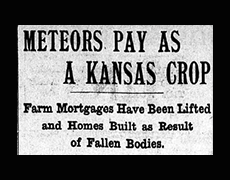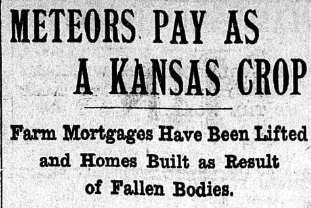
When there is a drought and no harvest to be had, men and women in Kansas went into their fields and began digging up meteorites to sell. Some were so successful at this that they were able to pay off their farms and put some money aside for living.
Meteors Pay as a Kansas Crop

LAWRENCE, Kansas. March 31, 1905. – Probably no state in the United States has had the strange incidents resulting from the fall of meteors as has Kansas, and probably no man in Kansas is as familiar with the unconventional incidents connected with their fall as Dr. F.H. Snow, professor of organic evolution, systematic entomology and meteorology of the state university.
Farm mortgages have been lifted, homes built and money saved for old age on the profits of meteorite trade in the sunflower state. It has really been a trade, and at times the centers of the meteorite fields have been the scenes of business activities, because there is a big demand in eastern and European markets for the celestial bodies that have struck the Kansas plains.
The phenomena of these terrestrial substances was practically unknown to the average Kansan until 1890, when a sort of meteoric panic sprung up in Kiowa county, and farmers that had their last 80 acres mortgage bound were in some instances saved from financial destruction by the find of meteorites on their land.
It was in April, 1890, that Dr. Snow first found any traces of the heavenly bodies. The news that came to him was indirect, but he immediately sent an agent to Kiowa county. Upon the agent’s report that all meteorites had been sold.
When he arrived at Greensburg he found that New York representative had been trying to buy all the meteorites and that his agent had missed valuable sales by a fraction of an hour.
Dr. Snow found A.B. Kimberly, who had obtained possession of most of the meteorites which had been found in that section.
At first Kimberly refused to consider Dr. Snow’s solicitations, but finally led the scientist around the end of a haystack and after some digging and scratching revealed a small meteorite, which was immediately bought by Professor Snow.
Mr. Kimberly had already sold more than 2,000 pounds of this new kind of fortune maker, and it took little persuasion by Dr. Snow to obtain Kimberly’s services for further search. Kimberly said he knew where there was another large meteorite, but a lawyer owned it and it probably would be hard to buy.
Kimberly went to the lawyer, who had been using the meteorite as a yard ornament for ten years. Kimberly induced the lawyer to sell it for $3, and within an hour sold it to Dr. Snow for $150.
This was a harvest for Kimberly and saved his farm when every foot of it was mortgaged and foreclosure seemed certain.
Woman Saved up the Meteors
The meteorites were first discovered by cowboys, who knew absolutely nothing of their value.
One day Kimberly’s wife was reading of fallen meteors and their value. She believed the stony substances would be invaluable, but the husband refused to listen to her and repeatedly bartered the meteorites off for meager offerings.
Just as often as Kimberly bartered the meteorites his wife managed to get possession of them, although ridiculed by her neighbors and members of her family.
By the time Kimberly had sold the first 2,000 pounds and other masses to Dr. Snow, he had more money to put in the bank than his crops had netted him in several years.
An incident demonstrating the great desire of collectors for this meteorites occurred when Dr. Snow bought a 218 pounder from a farmer named Evans in Brenham. He found Evans on his farm, but the meteorite was in town at a grocery store.
On the way to town, Dr. Snow closed the deal whereby he gave Evans $500 for his prize.
When they reached Brenham, a telegram was away Evans from Mr. Kuntz of New York, who had offered $1,100 for the meteorite. The agent threatened litigation, but Dr. Snow finally convinced him that the $500 sale was closed before the message had any effect.
Dr. Snow was offered $1,500 for this 218 pound meteorite by the directors of the Austrian Museum in Vienna, but refused, and still has it in his collection in the University Museum.
Dr. Snow received a letter a year ago from Kimberly’s son. He had been making a meager living by day labor and raising hogs. While feeding his hogs his foot hit a hard substance nearly buried under ground.
When he found it was a meteorite he wired Dr. Snow and the sale was immediately made, whereby Dr. Snow bought the stone composition, which weighed 168 pounds. It is now in the American National Museum in New York City.
The meteorite was an exceptionally rare one and is the largest of its kind in the world.
It took several hundred dollars to persuade young Kimberly to part with it, and Dr. Snow, in his sale to the New Yorkers, cleared enough to give him a profit.
Many Meteorites Found
The Kiowa county fall was of unusual quantity and 25 to 30 meteorites have been found there. Most of them were sliced and polished and the slices have brought high prices.
Dr. Snow, in his collection, has one of the few in the world that have been left just as found. It is estimated by scientists that not more than two or three whole Kiowa County meteorites, or of similar composition, are in the possession of any museum or scientist at the present time.
On farms where the meteorites were found in Kiowa county, the farmers ploughed their land as it had never been ploughed before.
On some farms the ground was ploughed and cross ploughed two and three times.
Washington county has a share in the fall of meteors. But thus far only one has been found that was worthy to be placed on the market.
B.C. January, a farmer living near Washington, was visited by a meteor fall at noon one day in July, 1890. He took his meteorite to county fairs and charged an admission fee to see it. Before he sold it to Dr. Snow, January had cleared several hundred dollars on his “meteorite show.”
As January lived on a rented farm, a woman in New York, who owned the place, instructed her agent to bring suit for recovery of the meteorite. Dr. Snow paid the agent money in addition to that paid January and settled the title. Several eastern firms made offers of $800 to $1,200 for this meteorite.
Another all meteorite was ploughed up on a farm near Tonganoxie, in Leavenworth county. H.C. Fellow found it while preparing the ground for corn. It weighs fifteen pounds and is polarized. One end is an attractive magnet and the other repulsive.
In 1896 a meteorite weighing less than six pounds fell on Joseph Black’s farm in Franklin county and struck within 200 yards of where Mr. Black was standing. Mr. Black found that it had buried itself more than a foot and had cut off cornstalks.
All of the meteorites in the university museum here belong to Dr. Snow. The board of regents has never deemed it advisable to buy these valuable specimens in the face of the financial needs of the institution. It is probable that in a few years some means will be devised whereby the university will come into permanent possession of the meteorites that are now left within Kansas borders.
Source: The Minneapolis journal. (Minneapolis, Minn.), 31 March 1905.

